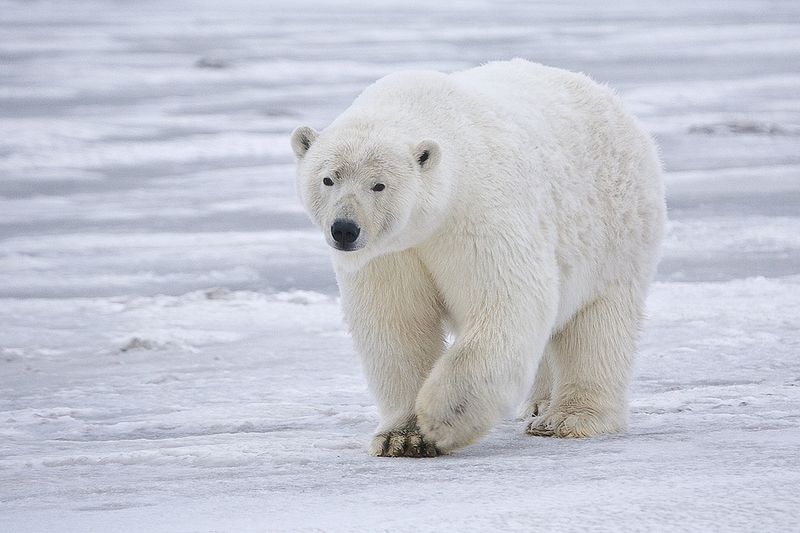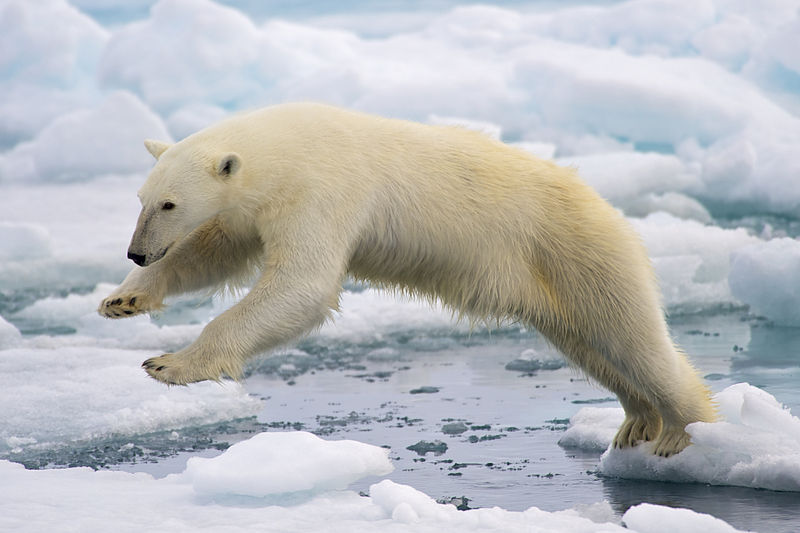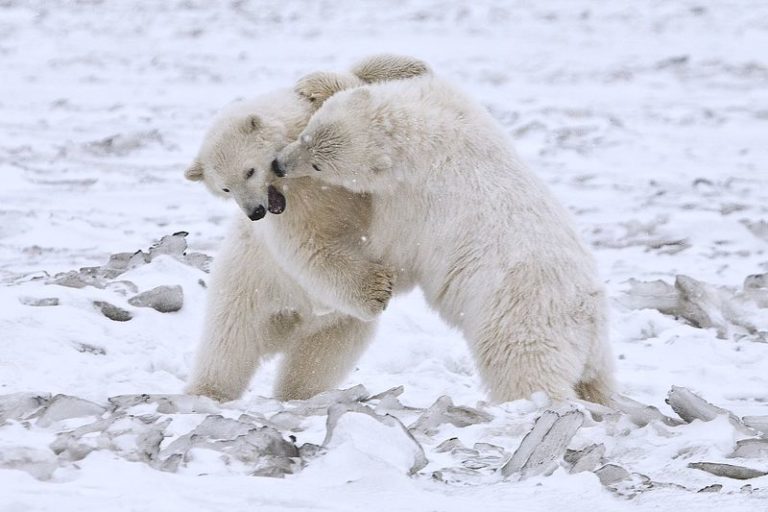Richly donned in heavenly white, you’ve seen or heard about polar bears from somewhere in one form or another. Do you think polar bears are just regular bears with white furs and coats? Have you wondered what makes polar bears different from the bears we know Hopefully, these polar bear facts for kids will clear up some of these common questions.
Polar bears are marine mammals because they spend most of their time at the sea and coasts. They primarily live in the colder regions of the earth and depend on sea ice. Despite being marine mammals, polar bears can still move quickly on land.
Polar bears are hypercarnivores, and their diet consists of more than 70% meat. They are large animals for their size and have strong and furry feet linked with sharp and stocky claws. This gives them friction while on land and also help in hunting their prey.
If you want to find a polar bear, you will probably have to see them on TV or the internet. Polar bears live within the range of the Arctic circle, above the latitude of 66 degrees. Probably not a place you will be able to see them in the wild.
This means that polar bears live in the northernmost parts of the North American continent, like Canada and the US. The circle also encompasses a big chunk of the country of Greenland and Norway, along with the northern parts of Russia.
Did you know that the Arctic was named after bears? In Latin, Arctic means ‘the bear,’ concerning the constellation Ursa Major. Perhaps that is why polar bears are a part of the Ursus genus in the scientific classification of the animal kingdom. Lets learn some more fun facts about polar bear!

Polar Bear Facts For Kids: Fast Facts
Fun Polar Bear Fast Facts
Scientific Name -Scientific Name: Ursus Maritimus (Maritime Bear)Genus: UrsusType: MammalDiet: Hypercarnivore (70% of diet is meat).Average Life Span: Less than 25 YearsSize: 2.4 to 3 Meters Or 7 Feet 10 Inches to 9 feet 10 inchesWeight: 770-1500 pounds or 350 – 700 kg
More Polar Bear Facts For Children
Polar bears have many secrets that are not known. Here is a small list that has been unraveled with research about them.
Quick Fun Facts About Polar Bears

- Polar bears are so strong, they can swim for days and days without end. They are also the only species that can do this
- Polar bears do not hibernate. They are dormant for some time, but this state of dormancy is not called hibernation
- During hibernation, many bears do not eat. They can spend months in starvation
- Polar bears have the shortest tails in the bear family.
- Polar bears don’t eat penguins because penguins aren’t present in the North Pole regions. They feed on bearded and ringed seals.
- They have poor eyesight but have an excellent sense of smell. They can detect prey from almost 14 miles away.
- Polar bears’ skin is black and their fur appears bright and white. In the summer, their coats turn yellow, and with disease and old age, the fur may become black.
- They have 42 teeth in their mouth.
- As a way of greeting, polar bears circle each other and grunt. Then when they’ve recognized one another, they touch their noses.
- In 1911, Greenland’s currency of five kroner had a polar bear printed in the bottom center.
- Polar bears live in only 5 countries across the world. United States, Norway, Greenland, Canada and Russia.
- Some other common nicknames for polar bears are, Sea Bears, White Bears or Beliy Medved in Russia, Isbjorn in Denmark, Lord of The Artic, Ice Bear and Nanuk to the Intuits. Nanuk means animal worthy of great respect.
- The largest polar bear ever found was 2,209 pounds or 1,000 kilograms. That is just about the size of a car!
- Their paws can measure up to 12 inches or 30 centimeters across!
- They have excellent smell. A polar bear can smell a seal from 20 miles away across the ice.
Fun Polar Bear Video For Children
Polar bears have a mating season that ties into their dormancy/part hibernating period. They go without food for many long months but will eat when March comes. What else does their life look like? This video about more facts about polar bears explains it all.https://youtu.be/1zRGzlWqce4
Polar Bears & Intuit Indigenous People
Polar bears are a significant icon of faith and generosity to the indigenous tribes that live in the Arctic Circle, especially the Inuit. Polar bears have great use and helped these tribes tremendously. Be it the fur, the meat, the blubber, or the claws, all of them are fruitful assets for the people.
As a form of gratitude, respect, and honor, these tribes celebrated the bears’ utility in the form of a polar dance. The bear’s skull is set out on an ice floe and sent back into the water so that the spirit is released back into the sea from where it came.
Polar bears have a layer of fat called blubber that the tribes around the Circle use to cook their meals. Even otherwise, this blubber is a layer of insulation for the bears, along with their clear fur. It helps them live in the harshest climate conditions on earth, i.e., the polar areas. Their black skin absorbs whatever heat and warmth is possible in the region.
Polar bears also tend to form a major part of the marine ecosystem. Their study helps researchers and scientists figure out the rate and extent of changes in the Arctic region.
Interesting Facts About Polar Bear Q&A

What Are Baby Polar Bears Called?
Baby polar bears are called cubs. The female polar bears are referred to as Sow. The cubs are generally born around November-December in snow dens when the bears are all in their dormant state. It’s pretty normal for polar bears to have two cubs. These polar bear cubs will stay with their mother for about two and a half years while learning to survive and hunt for food.
Why Are Polar Bears Endangered?
Polar bears have been categorized as ‘Vulnerable’ species. They are endangered animals because the area occupancy for them is diminishing due to climate change and other factors like pollution and oil and gas developments. This is responsible for the decrease in the quality of their habitat, due to which their population is predicted to decrease.
Climate change also creates nutritional stress. Many cubs do not survive because when their state of dormancy ends in March, there is often no food in sight. The change affects the sows’ ability to build proper snow dens to give birth.
Check out
Do Polar Bears Eat Penguins?
Polar bears don’t feed on penguins because penguins are not found where polar bears live. Polar bears live in the North pole while penguins live in the south. They feed on seals instead. A polar bear is an apex predator which means that nothing eats them.
Learn some cool Emperor Penguin Facts and then you can check out some Little Blue Penguin Facts too!
Are Polar Bears Actually White?
A polar bears fur is actually transparent. Although they seem white because their fur reflects the visible light and they are typically surrounded by white snow. Polar bears are actually black underneath their fur. They have a thick layer of fat that measures about 4.5 inches or 11.5 centimeters to help them stay warm and insulated both on land and in water. Polar bears look the most white when they are in the sunlight and clean. When they eat seals their fur can absorb some of the oils and make them look yellowish. Back in 1979, at the San Diego Zoo, there were some polar bears that actually turned green! They had algae grown on their hollow hair shafts. The zoo was able to correct the algae and turn the polar bears white again!
Is It Important To Protect & Conserve Polar Bears & Why?
Polar bears are used as a signal that there could be problems with the marine ecosystem in the artic since they are at the top of the food web. As the artic starts the warm up and the ice melts, they are probably the most impacted animal.
For thousands of years polar bears have also been a very important part of economies and cultures of the Artic people. They cannot exist where they do without sea ice. Their existence is impacted severely by climate change. They serve a very important role as an indicator species, not just for their species but for all artic marine life.
You can learn more about conservations efforts and what you can do to help below!
Click Here To Learn More About Polar Bear Conservation!
Final Thoughts
Polar bears are incredible creatures. They are vulnerable, but they are not out of reach to be saved.
I Hope this article has brought you more insight into the lives and likes of polar bears. This article may also have broken some myths about polar bears. For more facts about many other animals, you can visit the website.
If you enjoyed this article, please make sure to check out some of our other great facts for kids! There are many different animals and more!




